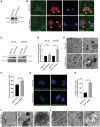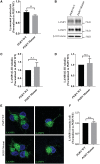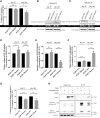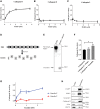Progranulin-mediated deficiency of cathepsin D results in FTD and NCL-like phenotypes in neurons derived from FTD patients
- PMID: 29036611
- PMCID: PMC5886207
- DOI: 10.1093/hmg/ddx364
Progranulin-mediated deficiency of cathepsin D results in FTD and NCL-like phenotypes in neurons derived from FTD patients
Abstract
Frontotemporal dementia (FTD) encompasses a group of neurodegenerative disorders characterized by cognitive and behavioral impairments. Heterozygous mutations in progranulin (PGRN) cause familial FTD and result in decreased PGRN expression, while homozygous mutations result in complete loss of PGRN expression and lead to the neurodegenerative lysosomal storage disorder neuronal ceroid lipofuscinosis (NCL). However, how dose-dependent PGRN mutations contribute to these two different diseases is not well understood. Using iPSC-derived human cortical neurons from FTD patients harboring PGRN mutations, we demonstrate that PGRN mutant neurons exhibit decreased nuclear TDP-43 and increased insoluble TDP-43, as well as enlarged electron-dense vesicles, lipofuscin accumulation, fingerprint-like profiles and granular osmiophilic deposits, suggesting that both FTD and NCL-like pathology are present in PGRN patient neurons as compared to isogenic controls. PGRN mutant neurons also show impaired lysosomal proteolysis and decreased activity of the lysosomal enzyme cathepsin D. Furthermore, we find that PGRN interacts with cathepsin D, and that PGRN increases the activity of cathepsin D but not cathepsins B or L. Finally, we show that granulin E, a cleavage product of PGRN, is sufficient to increase cathepsin D activity. This functional relationship between PGRN and cathepsin D provides a possible explanation for overlapping NCL-like pathology observed in patients with mutations in PGRN or CTSD, the gene encoding cathepsin D. Together, our work identifies PGRN as an activator of lysosomal cathepsin D activity, and suggests that decreased cathepsin D activity due to loss of PGRN contributes to both FTD and NCL pathology in a dose-dependent manner.
© The Author 2017. Published by Oxford University Press. All rights reserved. For Permissions, please email: journals.permissions@oup.com.
Figures




Similar articles
-
Individuals with progranulin haploinsufficiency exhibit features of neuronal ceroid lipofuscinosis.Sci Transl Med. 2017 Apr 12;9(385):eaah5642. doi: 10.1126/scitranslmed.aah5642. Sci Transl Med. 2017. PMID: 28404863 Free PMC article.
-
Intracellular Proteolysis of Progranulin Generates Stable, Lysosomal Granulins that Are Haploinsufficient in Patients with Frontotemporal Dementia Caused by GRN Mutations.eNeuro. 2017 Aug 18;4(4):ENEURO.0100-17.2017. doi: 10.1523/ENEURO.0100-17.2017. eCollection 2017 Jul-Aug. eNeuro. 2017. PMID: 28828399 Free PMC article.
-
Progranulin Gene Therapy Improves Lysosomal Dysfunction and Microglial Pathology Associated with Frontotemporal Dementia and Neuronal Ceroid Lipofuscinosis.J Neurosci. 2018 Feb 28;38(9):2341-2358. doi: 10.1523/JNEUROSCI.3081-17.2018. Epub 2018 Jan 29. J Neurosci. 2018. PMID: 29378861 Free PMC article.
-
Progranulin deficiency in the brain: the interplay between neuronal and non-neuronal cells.Transl Neurodegener. 2025 Apr 16;14(1):18. doi: 10.1186/s40035-025-00475-8. Transl Neurodegener. 2025. PMID: 40234992 Free PMC article. Review.
-
New insights and therapeutic opportunities for progranulin-deficient frontotemporal dementia.Curr Opin Neurobiol. 2022 Feb;72:131-139. doi: 10.1016/j.conb.2021.10.001. Epub 2021 Nov 23. Curr Opin Neurobiol. 2022. PMID: 34826653 Review.
Cited by
-
Benzoxazole-derivatives enhance progranulin expression and reverse the aberrant lysosomal proteome caused by GRN haploinsufficiency.Nat Commun. 2024 Jul 20;15(1):6125. doi: 10.1038/s41467-024-50076-8. Nat Commun. 2024. PMID: 39033178 Free PMC article.
-
Progranulin mutations result in impaired processing of prosaposin and reduced glucocerebrosidase activity.Hum Mol Genet. 2020 Mar 27;29(5):716-726. doi: 10.1093/hmg/ddz229. Hum Mol Genet. 2020. PMID: 31600775 Free PMC article.
-
Molecular Pathways Involved in Frontotemporal Lobar Degeneration with TDP-43 Proteinopathy: What Can We Learn from Proteomics?Int J Mol Sci. 2021 Sep 24;22(19):10298. doi: 10.3390/ijms221910298. Int J Mol Sci. 2021. PMID: 34638637 Free PMC article. Review.
-
Next Generation Precision Medicine: CRISPR-mediated Genome Editing for the Treatment of Neurodegenerative Disorders.J Neuroimmune Pharmacol. 2019 Dec;14(4):608-641. doi: 10.1007/s11481-019-09849-y. Epub 2019 Apr 23. J Neuroimmune Pharmacol. 2019. PMID: 31011884 Free PMC article. Review.
-
The role of endolysosomal progranulin and TMEM106B in neurodegenerative diseases.Mol Neurodegener. 2025 Jul 26;20(1):86. doi: 10.1186/s13024-025-00873-6. Mol Neurodegener. 2025. PMID: 40713630 Free PMC article. Review.
References
MeSH terms
Substances
Grants and funding
LinkOut - more resources
Full Text Sources
Other Literature Sources
Miscellaneous

